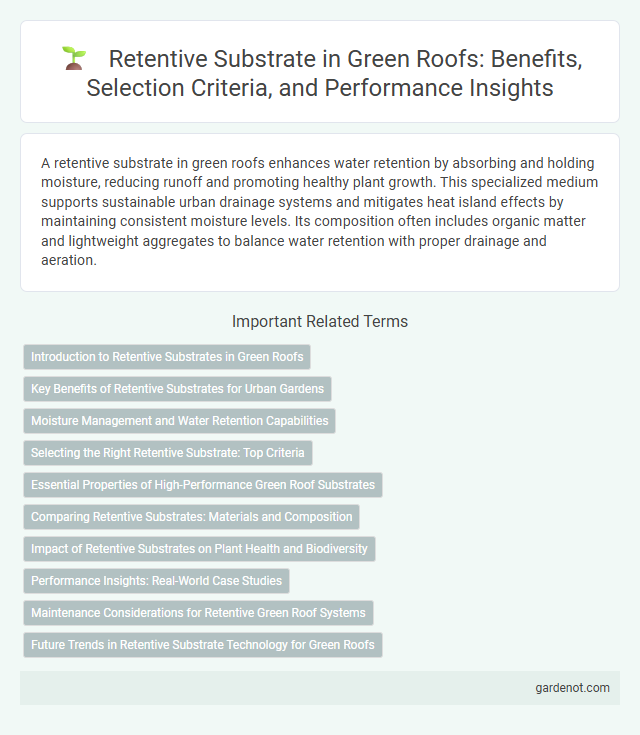A retentive substrate in green roofs enhances water retention by absorbing and holding moisture, reducing runoff and promoting healthy plant growth. This specialized medium supports sustainable urban drainage systems and mitigates heat island effects by maintaining consistent moisture levels. Its composition often includes organic matter and lightweight aggregates to balance water retention with proper drainage and aeration.
Introduction to Retentive Substrates in Green Roofs
Retentive substrates in green roofs are engineered growing mediums designed to maximize water retention while providing essential nutrients for plant growth. These substrates typically consist of lightweight materials such as expanded clay, perlite, and organic compost, which enhance moisture retention and drainage balance. Optimizing retentive properties improves stormwater management, reduces irrigation frequency, and supports healthy vegetation in extensive and intensive green roof systems.
Key Benefits of Retentive Substrates for Urban Gardens
Retentive substrates in urban gardens enhance water retention, reducing irrigation needs and promoting plant resilience during dry spells. These substrates improve nutrient availability, supporting healthy root development and vigorous plant growth in compact city environments. Their lightweight composition minimizes structural load on rooftops, making them ideal for sustainable green roof installations.
Moisture Management and Water Retention Capabilities
Retentive substrates in green roofs enhance moisture management by effectively capturing and storing rainwater, reducing runoff and promoting plant health. These substrates are engineered with high water retention capacities, allowing them to maintain adequate moisture levels during dry periods and support drought-resistant vegetation. Optimizing substrate composition with materials like expanded clay or lightweight aggregates significantly improves water retention, benefiting both ecosystem sustainability and building energy efficiency.
Selecting the Right Retentive Substrate: Top Criteria
Selecting the right retentive substrate for green roofs requires evaluating water retention capacity, porosity, and nutrient availability to ensure optimal plant growth and stormwater management. High-quality substrates balance moisture retention without causing root saturation, promoting healthy vegetation while preventing structural damage. Emphasizing lightweight materials with appropriate particle size distribution enhances drainage and aeration critical for sustainable green roof ecosystems.
Essential Properties of High-Performance Green Roof Substrates
High-performance green roof substrates require excellent water retention capabilities to support plant growth during drought periods while ensuring adequate drainage to prevent root rot. Essential properties include a balanced porosity that maintains moisture without waterlogging, lightweight composition for structural compatibility, and sufficient nutrient content to sustain vegetation. These characteristics optimize plant health and roof longevity in diverse environmental conditions.
Comparing Retentive Substrates: Materials and Composition
Retentive substrates for green roofs vary primarily in materials such as expanded shale, pumice, and lightweight expanded clay aggregates, each offering distinct water retention capabilities. Compositions rich in organic matter enhance moisture retention but must balance drainage to prevent root saturation. Comparing these substrates reveals that blended mixtures optimize both retention and aeration, crucial for sustaining diverse plant species under varying climatic conditions.
Impact of Retentive Substrates on Plant Health and Biodiversity
Retentive substrates play a crucial role in enhancing plant health by maintaining optimal moisture levels and nutrient availability, which supports robust root development and reduces drought stress. These substrates contribute to increased biodiversity by providing a stable microhabitat for various plant species and promoting beneficial microbial activity. Improved water retention and nutrient cycling foster a resilient green roof ecosystem, sustaining diverse flora and associated fauna.
Performance Insights: Real-World Case Studies
Retentive substrates in green roofs demonstrate superior water retention capacity, reducing stormwater runoff by up to 70% in urban environments. Case studies from New York City and Berlin highlight performance improvements in thermal regulation, with substrate layers maintaining surface temperatures 15-20% lower than traditional roofing materials. These real-world insights confirm the substrate's role in enhancing sustainability and resilience in diverse climatic conditions.
Maintenance Considerations for Retentive Green Roof Systems
Retentive substrates in green roof systems require periodic inspections to prevent substrate compaction and ensure optimal water retention capacity. Maintenance involves careful monitoring of moisture levels and prompt removal of debris to sustain plant health and enhance stormwater management performance. Regular replenishment of substrate nutrients supports vigorous vegetation growth and long-term system durability.
Future Trends in Retentive Substrate Technology for Green Roofs
Future trends in retentive substrate technology for green roofs emphasize enhanced water retention capacity and lightweight materials to improve stormwater management and structural load compatibility. Innovations include the integration of biochar and hydrogels, which increase substrate porosity and nutrient availability, supporting plant health and reducing irrigation needs. Advances in smart substrates with moisture sensors and self-regulating irrigation systems are poised to optimize water efficiency and sustainability in urban green roofing projects.
Retentive substrate Infographic

 gardenot.com
gardenot.com